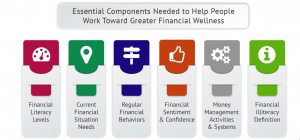The psychology of debt is a multifaceted and often underestimated dimension of financial transactions. While the nuts and bolts of borrowing and lending revolve around numerical figures, contractual agreements, and interest rates, the emotional and psychological elements embedded within these transactions wield considerable influence over the experiences and outcomes for both borrowers and lenders. This interplay of emotions and financial decisions reveals that there is much more to debt than meets the eye, and understanding these psychological aspects is integral to comprehending the complexities of debt dynamics.
On one hand, individuals who borrow money can be subject to a wide array of emotional responses. The process of borrowing often stirs feelings of anxiety and stress, stemming from concerns about accumulating debt, the ability to meet financial obligations, and the potential long-term consequences. Simultaneously, borrowing can evoke a sense of desire and immediate gratification, as individuals borrow to fulfill their aspirations and achieve significant life goals. These goals, whether it’s buying a home, pursuing education, or launching a business, can become powerful motivators for taking on debt. However, the emotional spectrum surrounding borrowing also encompasses feelings of shame and guilt, when borrowers struggle to repay their debts, leading to a sense of financial irresponsibility and damage to their self-esteem. Some borrowers may exhibit overconfidence and excessive optimism, causing them to underestimate the risks linked to debt and potentially leading to situations where they are trapped in a cycle of mounting debt. This intricate web of emotions experienced by borrowers underlines the profound impact of psychology on their financial decisions and overall well-being.
The borrower’s perspective
- Anxiety and stress: The emotional response of anxiety and stress when borrowing money is a prevalent and understandable reaction. Individuals may experience a sense of unease as they grapple with the fear of accumulating debt. This anxiety often arises from concerns about their capacity to make timely payments, meet their financial obligations, and navigate the potential long-term consequences. The uncertainty of whether they will be able to manage their debt effectively can take a toll on their mental well-being. These emotional challenges can be especially overwhelming for those who are new to borrowing or facing financial difficulties. The fear of falling into a cycle of debt and the burden of repayment can lead to increased stress levels, highlighting the significant psychological impact of debt.
- Desire and gratification: On the flip side, borrowing can also trigger emotions of desire and immediate gratification. Many individuals resort to borrowing to satisfy their desires or achieve significant life goals, such as homeownership, pursuing higher education, or realizing entrepreneurial dreams. The prospect of making these aspirations a reality can serve as a powerful motivator for taking on debt. This emotional connection between borrowing and personal fulfillment underscores the role of desire and ambition in shaping financial decisions. Borrowers often view debt as a means to access opportunities and experiences that may otherwise remain out of reach. The emotional satisfaction derived from achieving these goals can be a driving force behind borrowing decisions and contribute to a sense of accomplishment and happiness.
- Debt stigma : When borrowers find themselves struggling to repay their debts, emotions of shame and guilt can surface. These feelings are often intertwined with the perception of financial irresponsibility. Borrowers who face difficulties in meeting their repayment obligations may blame themselves and consider their actions a reflection of poor financial management. The emotional burden of shame and guilt can significantly impact one’s self-esteem and mental well-being. It may discourage individuals from seeking help or discussing their financial challenges with others, further isolating them in their debt-related distress. The stigma associated with financial difficulties can be a barrier to addressing debt issues and seeking support, making it a critical aspect of the psychology of debt.
- Overconfidence and optimism: Some borrowers exhibit overconfidence and excessive optimism when it comes to borrowing and managing debt. This psychological aspect can lead to risky financial behavior and poor decision-making. Overly optimistic borrowers may underestimate the risks associated with debt, believing that they can handle higher levels of borrowing without consequences. This mindset can lead to excessive borrowing and overextending their financial commitments. Over time, this overconfidence can result in a debt trap, where borrowers struggle to manage their mounting obligations. The psychological aspect of overconfidence and optimism highlights the need for financial education and awareness to promote responsible borrowing and realistic assessment of one’s financial capacity. Understanding the psychological factors at play can help borrowers make informed decisions, and lenders can provide more effective support and guidance.
The lender’s perspective
- Empathy and sympathy: Lenders often find themselves dealing with borrowers facing financial distress. The psychology of debt collections and lending necessitates the presence of empathy and sympathy towards these individuals who are going through challenging times. Lenders must not only assess financial data and creditworthiness but also consider the emotional challenges borrowers are experiencing. This empathy can lead to a better understanding of the borrower’s situation, allowing lenders to make more informed decisions. For instance, they may need to make tough choices about granting loan extensions or restructuring loans to provide relief. Balancing the need to protect the interests of the lending institution with empathy for the borrower’s difficulties is a delicate psychological process that lenders navigate.
- Risk aversion and trust: Lenders face the dual challenge of managing risk while simultaneously building trust with borrowers. Trust is a cornerstone of the lending relationship, and it is rooted in the psychological dynamics of lending. On one hand, lenders have a natural aversion to risks, and they must assess the creditworthiness and reliability of borrowers. On the other hand, they must establish trust with borrowers to maintain a healthy lending relationship. This trust extends beyond financial assessments and includes empathizing with the borrower’s circumstances, understanding their needs, and demonstrating a commitment to responsible lending. The psychology of lending involves striking a balance between mitigating risk and fostering trust, recognizing that one cannot be achieved at the expense of the other.
- Profit motive and responsibility: Lenders, whether in the form of banks, credit institutions, or individual investors, are inherently profit-driven entities. The psychology of lending also encompasses the desire to maximize returns on investments. Lenders seek to lend money with the expectation of earning interest or returns on their capital. However, this profit motive coexists with the ethical responsibility to ensure fair and responsible lending practices. The psychological challenge lies in finding the equilibrium between pursuing profit and upholding ethical responsibilities. Lenders must make decisions that are financially sound and ethically responsible, reflecting their commitment to borrowers’ well-being and the principles of equitable lending. This balance between profit motives and ethical responsibility is a critical aspect of the psychology of lending.
- Stress and decision-making: Lenders, especially those in roles that involve assessing and managing risk, often experience significant stress related to their decision-making processes. The pressure to make sound lending decisions that protect the institution’s financial interests while also considering the borrower’s situation can be emotionally taxing. Lenders may have to analyze complex financial data, evaluate risks, and make choices that impact both borrowers and the lending institution. This emotional burden can affect their decision-making, and they must employ stress management techniques to ensure that their choices are well-informed and aligned with the institution’s goals. The psychological aspect of stress and decision-making underscores the importance of training and support for lenders, enabling them to navigate the complexities of lending while maintaining their emotional well-being.
The intersection of emotions in debt
The world of borrowing and lending is a dynamic interplay of emotions. Both borrowers and lenders may experience fear, hope, frustration, empathy, and a range of other emotions throughout the debt cycle. Understanding these emotional dynamics is crucial for making informed financial decisions and ensuring that lending practices are not only financially sound but also ethically and emotionally sensitive.
Strategies for managing the emotional impact of debt
For borrowers:
- Financial literacy: Enhancing financial literacy is a vital aspect of addressing the anxiety and stress associated with borrowing money. Many individuals experience anxiety when it comes to financial matters, especially debt. When borrowers have a better understanding of financial concepts, such as interest rates, loan terms, and financial planning, they are more equipped to make informed and confident decisions. Financial literacy equips borrowers with the knowledge to assess various borrowing options, understand the implications of different loans, and evaluate their financial capacity. This knowledge reduces anxiety and stress because borrowers can approach financial decisions with more confidence. By providing resources and educational programs that enhance financial literacy, individuals can navigate the borrowing process with greater ease and peace of mind.

Source: National Financial Educators’ Council, USA
2. Budgeting: Budgeting is a fundamental tool that borrowers can use to regain control over their financial situation, thereby alleviating worries and stress. Creating a budget involves carefully planning and tracking income and expenses. By establishing a budget, borrowers can gain a clear overview of their financial situation, which can be empowering. They can identify areas where they can cut costs, allocate funds to repay debts, and set financial goals. This sense of control over their financial life reduces stress and worry as borrowers have a structured plan to address their debt and manage their finances. Moreover, adhering to a budget fosters financial discipline, enabling borrowers to stay on track with their financial objectives. Organizations and institutions can provide support by offering resources on budgeting, financial planning tools, and guidance to help borrowers create and stick to a budget.
3. Seeking support: Borrowers who find themselves in challenging financial situations should be encouraged to seek help from professionals and support services. This step is essential in addressing emotional struggles related to debt. Financial advisors and credit counseling services are valuable resources that can provide guidance, solutions, and emotional support. Financial advisors can offer personalized financial advice and strategies to help borrowers manage debt and alleviate the emotional burden associated with it. Credit counseling services are dedicated to assisting individuals in financial distress. They can negotiate with creditors, provide debt management plans, and offer emotional support to help borrowers regain control of their finances. Encouraging borrowers to seek support shows that organizations and institutions are committed to the well-being of their clients and customers, not only in terms of financial solutions but also in addressing the emotional toll that debt can take. By reducing the stigma associated with seeking help and providing accessible resources, borrowers are more likely to reach out and find assistance in managing their debt-related emotional struggles.
For lenders:
- Empathy training: Empathy training programs for lenders are a valuable tool in fostering understanding and support for borrowers facing financial challenges. These programs offer lenders insights into the emotional aspects of lending and dealing with borrowers in distress. By enhancing empathy, lenders can better comprehend the difficulties borrowers face, whether due to unexpected financial hardships or personal circumstances. Empathy training helps lenders develop better communication skills to engage with borrowers in a compassionate and understanding manner.
- Ethical guidelines: Adopting and adhering to ethical lending guidelines is crucial for ensuring that lenders maintain a balance between profit motives and responsible lending. Ethical guidelines outline principles and practices that promote fair, transparent, and responsible lending. By following these guidelines, lenders can ensure that their lending practices prioritize the welfare of borrowers alongside profit motives. Ethical guidelines address key aspects of lending, such as interest rates, transparency in loan terms, and providing clear information to borrowers.
- Effective decision-making support: Providing resources and support for lenders dealing with high-stress decision-making is essential in helping them manage the emotional toll of their roles. Lenders, especially those in roles that involve assessing and managing risk, often experience significant stress related to decision-making. The pressure to make sound lending decisions that protect the institution’s interests while also considering the borrower’s situation can be emotionally taxing. Providing decision-making support can include access to tools, data, and expertise that aid lenders in making informed and well-considered decisions.
Conclusion
In the world of borrowing and lending, numbers and contracts tell only part of the story. The profound influence of human emotions cannot be underestimated. For borrowers, the journey is often a rollercoaster of emotions that shape financial decisions and well-being. Simultaneously, lenders grapple with empathy, trust, profit motives, and stress in their pursuit of responsible lending. The psychology of debt repayment and collections is a realm where numbers meet emotions, and the interplay of these forces can determine financial destinies.
Understanding the emotional landscape of debt is essential for borrowers to make informed choices and for lenders to provide support when needed. It’s a reminder that financial decisions are not devoid of feelings and that empathy and education can play pivotal roles in creating a more balanced and emotionally healthier financial ecosystem. In a landscape where numbers can often feel overwhelming, it’s the understanding and management of how emotions impact borrowers and lenders, that truly define success.
If you are looking to transform your debt collections strategy with the power of digital and data-powered insights, reach out to us to request an exploratory session at sales@credgenics.com or visit us at www.credgenics.com
FAQs:
Q.1 Why do some borrowers experience anxiety and stress when taking on debt?
Borrowers often experience anxiety and stress because borrowing money carries significant financial responsibilities and implications. The fear of accumulating debt is tied to the uncertainty of whether they will be able to meet their financial obligations. Anxiety and stress arise as individuals worry about their ability to make timely payments, manage interest rates, and deal with the long-term financial consequences of their debt. These emotional responses highlight the need for financial literacy and the importance of managing these feelings when borrowing.
Q.2 How can emotions like desire and gratification impact borrowing behavior?
Emotions like desire and gratification can strongly influence borrowing behavior. When individuals desire something, such as a new home, advanced education, or a business opportunity, they may be willing to take on debt to fulfill these aspirations. This emotional drive for a better future can be a powerful motivator to engage in borrowing. It’s essential for borrowers to recognize the role of these emotions and strike a balance between achieving their goals and managing their financial health responsibly.
Q.3 What are the emotional consequences for borrowers who struggle to repay their debts?
Borrowers who find it challenging to repay their debts can experience a range of emotional consequences. Feelings of shame and guilt may emerge as they perceive themselves as financially irresponsible. These emotions can significantly impact their self-esteem and overall mental well-being. Importantly, such emotional burdens can hinder borrowers from seeking help or taking the necessary steps to address their debt issues. This highlights the importance of offering support and resources for individuals facing financial difficulties.
Q.4 Why do some borrowers exhibit overconfidence and optimism when it comes to debt?
Some borrowers exhibit overconfidence and optimism because they tend to underestimate the risks associated with debt. This can be influenced by a belief in their ability to manage debt successfully and a desire for the immediate gratification that borrowing can provide. However, excessive optimism can lead to poor financial decisions, such as taking on more debt than they can handle. Over time, this can result in debt traps and financial challenges. It underscores the importance of financial education and responsible borrowing practices.
Q.5 How do lenders navigate the emotional aspects of lending, such as empathy and trust?
Lenders face the challenge of balancing empathy and sympathy with the need to minimize risks and build trust with borrowers. They must be sensitive to borrowers’ emotional challenges, especially when borrowers are facing financial hardships. Empathy and understanding the borrower’s emotional situation are essential for maintaining a healthy lending relationship. Building trust is crucial in the world of lending, and it requires a deep understanding of both the borrower’s financial and emotional state. Lenders need to make informed decisions that protect their institution’s interests while considering the borrower’s emotional well-being. This involves not only assessing financial risks but also acknowledging the psychological aspects of lending.





